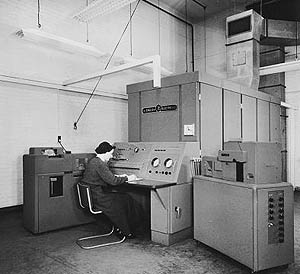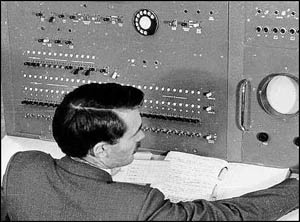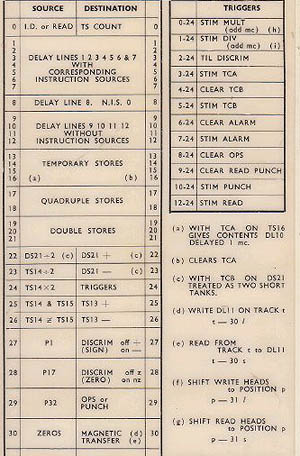In my last blog post I wrote about entering the computer industry in 1964 when computers were already into what was called the second generation. But, I did get to work with a first generation computer, and quite an experience it was.
I suppose, to be correct, I should say, the first generation of electronic computers. It could be argued that the first real programmable computer was designed in the 1820s by Charles Babbage. Unfortunately though, he was always so busy designing and improving them that he never actually built one!
As part of my initial training, I and a few other new programmers, studied one day a week at what was then the Staffordshire College of Technology. Now I believe it’s one of those new universities that issue degrees to anyone who can stay awake for one lecture a week for few months of the year.
The college had a computer, a first generation DEUCE. It had been donated by English Electric, once the second generation systems became the norm. The name DEUCE was an acronym for Digital something or other, but was supposedly given the name because it superceeded the earlier ACE, and then someone had to figure out what words should match the letters. But, I’ll come back to DEUCE in a moment…
The whole experience of attending this college was a bit bizarre. The small group of us used to take a thirty minute train ride to Stafford, where we were met by a chauffeur-driven vintage Rolls Royce. We figured this VIP treatment was somehow connected with the donation of what would have been a very valuable computer. But it was like a scene out of Downton Abbey. The chauffeur in his morning suit, and the car a genuine 1920-something specimen, always looking immaculate with its polished black paint, gold trim, and beige leather upholstery. The thing I remember most was the gear lever, typical of Rollers of that age, situated on the floor between the driver’s seat and the door. Not that the chauffeur had to use it much because the thing had a 0-60 time of about three weeks.

So we chugged from the station to the college at about 9am, and chugged back to the station at about 6pm. In between, not much studying was done, because none of us could see much point. They weren’t teaching us anything about computing, and as I recall, we spent most of the time in the canteen playing cards. I do recall one of our group, who I hardly knew, was a very sweet young thing, with what those pulp fiction novels would call “ample rounded lips.” I’m not sure if she was a mind reader, but during one mid-afternoon break she suddenly announced to those assembled, that she thought kissing was the most disgusting thing imaginable, and that she had never kissed anyone and never would. Which nicely buggered-up my plans for the evening.

But back to DEUCE. It was big. It was housed in a huge gun-metal gray cabinet typical of the day. To do any kind of maintenance, you opened the door … not to peer inside, but to walk inside. It was the only computer I can recall that you could physically walk into. And walking into it was a regular occurrence for the engineers, because with all those vacuum tubes and primitive circuitry, it was, well, less than reliable.

To use the computer, you sat at large equally-gray console. Communicating with the computer was done via several rows of switches, and it “replied” by showing rows of dots on a couple of small cathode ray tubes. I would have written CRTs, but I don’t mean the modern display devices that preceded LCD panels.
One unique feature of the DEUCE was its register storage, the place you put instructions and things that were being computed, and could be needed real soon. It consisted of twelve long metal tubes, filled with mercury. These were used in pairs, so that an acoustic signal sent from the top of one tube would be reflected back into the adjacent tube and received again at its top. This enabled all the transmitters and receivers to be placed together, and all the tubes were grouped inside a drum, looking much like a metal trash can! Any data that was needed, was removed from the queue as it came out of the tube, and any that would be needed later was sent back down the first tube again.

In this day and age it sounds utterly bizarre to turn data into sound so that you can send into columns of mercury, after which you turned the sound waves back into data. But without the benefit of silicon chips, designers had to be very creative. The whole thing worked, because the sound waves were slowed by the mercury, and the delay lines could temporarily store 32 instructions of 32-bit words.

Programming the beast took enormous skill. The most efficient programs were the ones where data or instructions popped out of the delay lines just as you needed them. If you missed what you needed, the data had to go around for another cycle. I guess a bit like your washing machine working permanently, only stopping for one minute after every wash cycle. Miss that minute and your laundry gets washed again. So, in the same way that you are not about to go to work without your clean underwear, a program had to stop until it had the needed data.
Now that I’ve finished comparing softwear and software, what the deuce did I do with it?
Well, if the computer was available, which it often was because as I mentioned, the college didn’t teach computing, the programmers from English Electric could book an hour of computing time. There was no way I could have learned to program in machine code, worrying about my data zipping around in those columns of mercury, but I did do some programming in Autocode, a rather higher-level language. But in a one hour period, you couldn’t achieve much more than reading a reel of paper tape and adding a couple of numbers together. Especially when it was unusual for the thing to keep running for a whole hour.
So, yes, it was slow. It’s a little difficult to make comparisons, but I’d say the processor in an iPhone 4S would be tens of thousands of times faster than the DEUCE. And the iPhone is, well, just a little bit smaller!
Nonetheless, I felt privileged to have worked on a piece of computer history.
